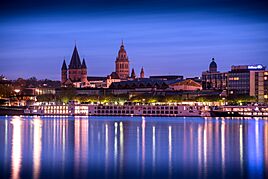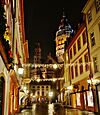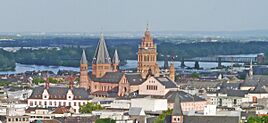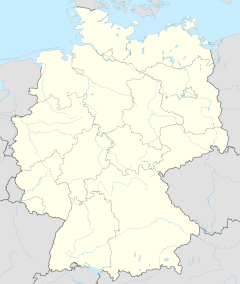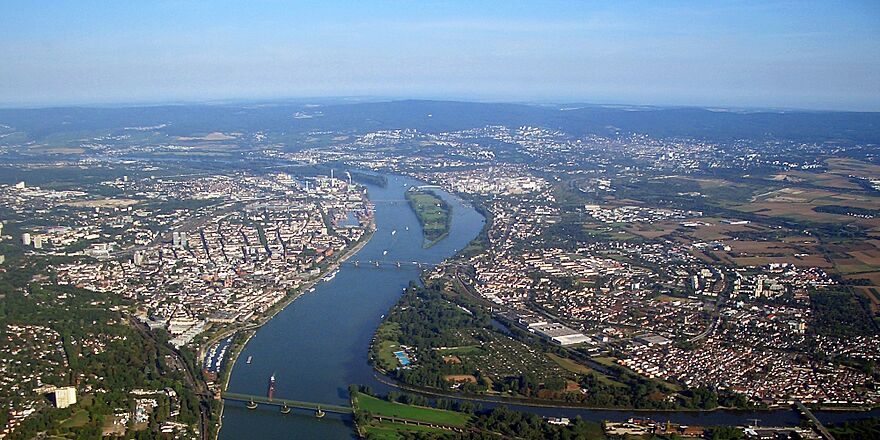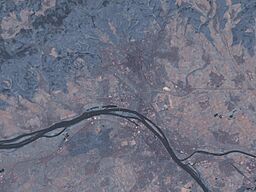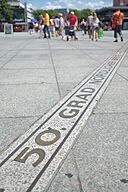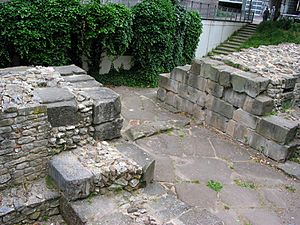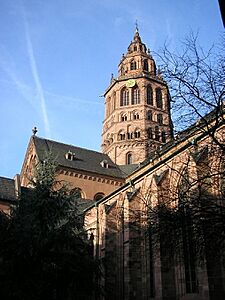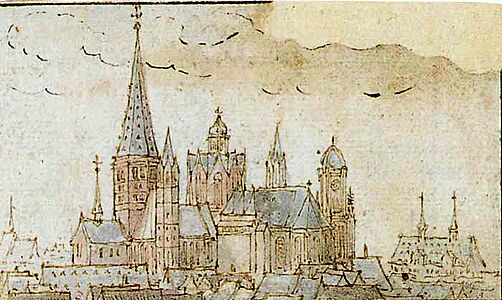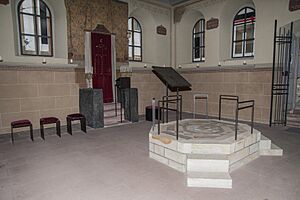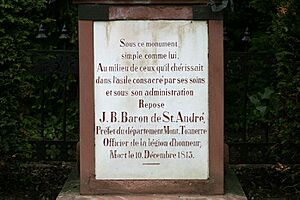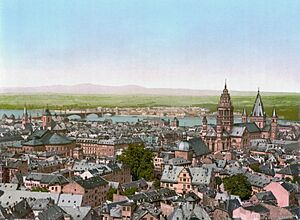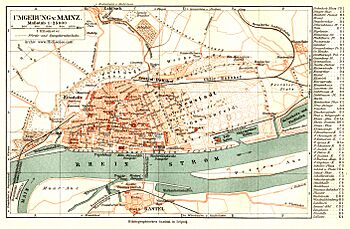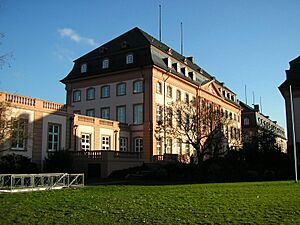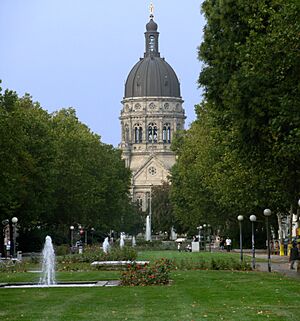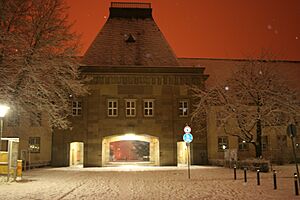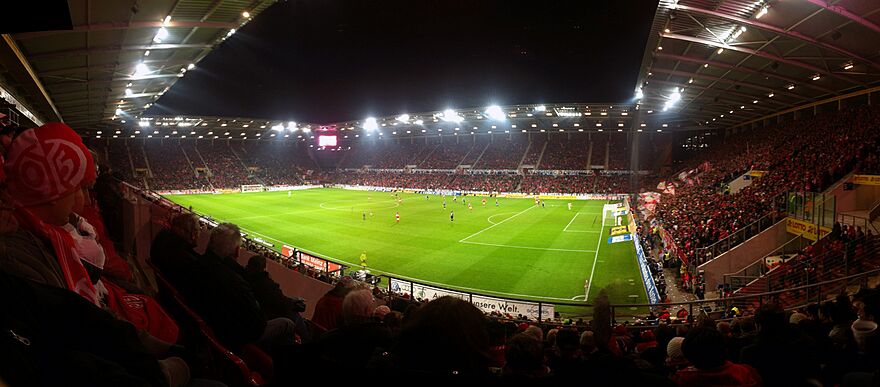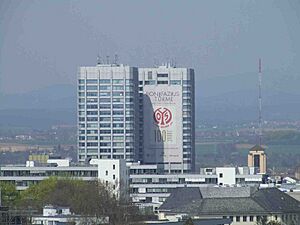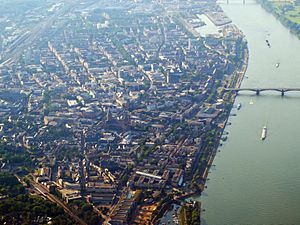Mainz facts for kids
Quick facts for kids
Mainz
|
|||
|---|---|---|---|
|
|||
| Country | Germany | ||
| State | Rhineland-Palatinate | ||
| District | Urban district | ||
| Founded | 13/12 BC | ||
| Subdivisions | 15 boroughs | ||
| Area | |||
| • Total | 97.75 km2 (37.74 sq mi) | ||
| Highest elevation | 285 m (935 ft) | ||
| Lowest elevation | 85 m (279 ft) | ||
| Population
(2022-12-31)
|
|||
| • Total | 220,552 | ||
| • Density | 2,256.29/km2 (5,843.76/sq mi) | ||
| Time zone | UTC+01:00 (CET) | ||
| • Summer (DST) | UTC+02:00 (CEST) | ||
| Postal codes |
55116–55131
|
||
| Dialling codes | 06131, 06136 | ||
| Vehicle registration | MZ | ||
| Website | www.mainz.de | ||
| Official name: ShUM Sites of Speyer, Worms and Mainz | |||
| Type: | Cultural | ||
| Criteria: | (ii)(iii)(vi) | ||
| Designated: | 2021 | ||
| Reference #: | [1] | ||
Mainz is a big city in Germany. It is the capital of the state of Rhineland-Palatinate. About 223,000 people live here. Mainz is part of a large area called the Rhine-Main Metropolitan Region. This region includes other cities like Frankfurt am Main and Wiesbaden.
Mainz is on the left side of the Rhine River. It is across from Wiesbaden, the capital of Hesse. The River Main also flows into the Rhine here. Mainz is known for its mild weather. This makes it a great place for growing grapes. It is one of Germany's most important wine regions. You can easily get to Frankfurt from Mainz by train.
The city was first built by the Romans around 13 BC. It was called Mogontiacum. Later, in the 8th century, it became a very important city in the Holy Roman Empire. It was home to powerful church leaders called Archbishop-Electors. The Mainz Cathedral is one of three famous cathedrals in this area.
Since the 12th century, Mainz was one of the special ShUM-cities. These cities, Speyer, Worms, and Mainz, were important centers for Ashkenazi Jewish life in the Middle Ages. Their Jewish heritage is so unique that it is a UNESCO World Heritage Site. This includes the Judensand cemetery, which is one of the oldest Jewish cemeteries in Europe.
Mainz is also the birthplace of Johannes Gutenberg. He invented the movable type printing press. This invention changed the world by making books easier to print. Gutenberg printed his first books, including the famous Gutenberg Bibles, in Mainz around 1450. You can see some of these Bibles at the Gutenberg Museum in the city.
During World War II, Mainz was badly damaged by air raids. About half of the old town was destroyed. But many buildings were rebuilt after the war. Like other cities in the Rhineland, Mainz has big carnival celebrations. These are very famous in Germany. The city is also home to ZDF, a major German TV broadcaster.
Contents
- Different Names for Mainz
- Mainz's Location and Surroundings
- Mainz Through the Ages
- Mainz's Cityscape and Buildings
- Places to See in Mainz
- How Mainz is Governed
- Mainz's Population and People
- Mainz's Culture and Traditions
- Learning and Education in Mainz
- Sports in Mainz
- Mainz's Economy and Industries
- Getting Around Mainz
- Famous People from Mainz
- Mainz's Sister Cities
- See also
Different Names for Mainz
Mainz has been called many different names over time. In Latin, the Romans called it Mogontiacum. In the local dialect, people say Määnz or Meenz.
Other countries also have their own names for Mainz:
- In French, it is called Mayence.
- In Italian, it is Magonza.
- In Spanish, it is Maguncia.
- In Polish, it is Moguncja.
- In Yiddish, it is Magentza.
- In Czech and Slovak, it is Mohuč.
Before the 1900s, English speakers often called it Mentz or used its French name, Mayence.
Mainz's Location and Surroundings
Where is Mainz Located?
Mainz is located on the left bank of the Rhine River. It sits at the 50th parallel north. This is a line of latitude around the middle of the Northern Hemisphere. The city is part of the larger FrankfurtRheinMain area. This area has about 5.9 million people.
You can easily reach Mainz from Frankfurt International Airport. It's about a 30-minute ride by train. The city also has a busy river port on the Rhine. This river is one of Germany's most important waterways. The port helps move goods in and out of the city.
After the last ice age, sand dunes formed in the Rhine valley. These dunes are now a nature reserve. It's a special place with unique plants for this area.
Mainz's Weather and Climate
Mainz has an oceanic climate. This means it has mild winters and warm summers. It gets rain throughout the year. The weather is generally pleasant, which helps with the local wine industry.
| Climate data for Mainz | |||||||||||||
|---|---|---|---|---|---|---|---|---|---|---|---|---|---|
| Month | Jan | Feb | Mar | Apr | May | Jun | Jul | Aug | Sep | Oct | Nov | Dec | Year |
| Mean daily maximum °C (°F) | 3.4 (38.1) |
5.3 (41.5) |
9.7 (49.5) |
14.2 (57.6) |
19 (66) |
22.0 (71.6) |
24 (75) |
23.6 (74.5) |
20.1 (68.2) |
14.3 (57.7) |
8 (46) |
4.5 (40.1) |
14.0 (57.2) |
| Mean daily minimum °C (°F) | −1.2 (29.8) |
−0.6 (30.9) |
1.9 (35.4) |
4.8 (40.6) |
8.7 (47.7) |
11.9 (53.4) |
13.4 (56.1) |
13.2 (55.8) |
10.3 (50.5) |
6.6 (43.9) |
2.5 (36.5) |
−0.1 (31.8) |
5.9 (42.7) |
| Average precipitation mm (inches) | 38 (1.5) |
36 (1.4) |
38 (1.5) |
38 (1.5) |
51 (2) |
58 (2.3) |
56 (2.2) |
53 (2.1) |
41 (1.6) |
43 (1.7) |
48 (1.9) |
46 (1.8) |
550 (21.5) |
| Source: Intellicast | |||||||||||||
Mainz Through the Ages
Roman Times: Mogontiacum
Mainz started as a Roman military camp called Mogontiacum. It was built by General Nero Claudius Drusus around 13 BC. The Romans chose this spot because it was important for defending their empire. It was located where the Main River meets the Rhine.
The name "Mainz" comes from "Mogontiacum". It might be linked to a Celtic god named Mogons. This god was associated with "greatness" or "might."
Mogontiacum was a key Roman town. It had a large military base and a fleet of ships on the Rhine. In 1982, remains of Roman ships were found. You can see them at the Museum für Antike Schifffahrt. A temple dedicated to the gods Isis and Cybele was also found.
The city had a huge theater, the biggest north of the Alps. There was also a bridge across the Rhine. The Drususstein is a monument built by Roman soldiers to honor General Drusus. It still stands today.
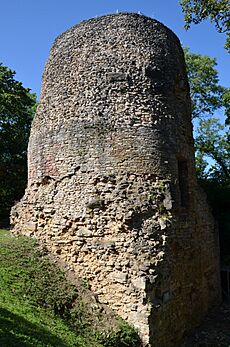
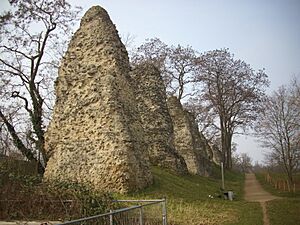
Mainz was attacked by Germanic tribes many times. In 368, the Alemanni sacked the city. Later, in 405 or 406, other Germanic tribes crossed the Rhine near Mainz. Despite these attacks, the Roman military presence in Mainz continued for a long time. The current citadel was built in 1660 on the site of older Roman forts.
Frankish Rule in Mainz
The Franks took control of Mainz around 460 AD. After the fall of the Western Roman Empire, the Frankish king Clovis I built a large empire. Mainz became an important city in this new Frankish empire.
Charlemagne, a very famous Frankish ruler, expanded the empire even more. Mainz's central location made it important for his empire and for spreading Christianity. After Charlemagne's death, the empire split. Mainz became part of East Francia, which later became Germany.
Mainz as a Christian Center
|
Free City of Mainz
Freie Stadt Mainz
|
|||||||||
|---|---|---|---|---|---|---|---|---|---|
| 1244–1462 | |||||||||
| Status | Imperial city | ||||||||
| Capital | Mainz | ||||||||
| Historical era | Middle Ages | ||||||||
|
• City established
|
c. 13 BC | ||||||||
|
• City charter granted
by Abp Siegfried III |
1244 | ||||||||
|
• Rival archbishops
|
1461 | ||||||||
|
• Charter revoked by
Abp Adolph II |
1462 | ||||||||
|
• German Mediatisation
|
1803 | ||||||||
|
|||||||||
In the early Middle Ages, Mainz played a big role in spreading Christianity. Boniface, the first archbishop in Mainz, was a missionary. He is buried in Fulda. The archbishopric of Mainz was officially set up in 781.
The Archbishops of Mainz were very powerful. They held high positions in the Holy Roman Empire. The Roman Catholic Diocese of Mainz is special because it is the only one with an episcopal see called a Holy See.
In 1244, Archbishop Siegfried III gave Mainz a city charter. This allowed citizens to have their own city council. Later, in 1461, there was a conflict between two archbishops. This caused problems in the city. People who opposed one archbishop, like Johannes Gutenberg, were forced to leave.
-
Monument to St. Boniface before Mainz Cathedral
-
St. Martin's Cathedral in Mainz, by Wenzel Hollar; pen-and-ink drawing 1632
Mainz's Jewish Community
The Jewish community in Mainz is very old, dating back to the 10th century. It was famous for its religious teaching. Rabbi Gershom ben Judah taught here. Mainz was one of the three "ShUM" cities (Speyer, Worms, and Mainz). These cities were important centers for Jewish learning in the Middle Ages.
The city's relationship with its Jewish population changed over time. Sometimes they were protected, and other times they faced difficulties. There were times when Jewish people were forced to leave Mainz. Sadly, they were also sometimes blamed for outbreaks of disease, like the Black Death.
There is an old Jewish cemetery outside the city center. It has over 1500 gravestones. The oldest one dates back to 1062 or 1063. Today, the Jewish community in Mainz is growing. A new synagogue was built in 2010. It stands where the old one was destroyed in 1938.
Mainz and the French Revolution
During the French Revolution, the French army took over Mainz in 1792. Some people in Mainz, called Jacobins, wanted to create their own republic. They called it the 'Republic of Mainz' in 1793. They wanted to join France.
But Prussian troops soon took back the city. After a long siege, the French left. The Republic of Mainz ended. Later, in 1797, the French returned. Napoleon Bonaparte's army occupied the area west of the Rhine. Mainz became the capital of a new French region. But after Napoleon's defeats, the French left Mainz in 1814.
Mainz in the 19th Century
In 1816, Mainz became part of the Hesse-Darmstadt. It was the capital of a new province called Rhenish Hesse. Mainz was an important fortress to defend against France. It had many Austrian, Prussian, and Bavarian soldiers.
In 1857, a large explosion happened in Mainz. The city's powder magazine, the Pulverturm, exploded. Many people were killed or hurt, and buildings were destroyed. This event is known as the Powder Tower Explosion.
After Germany became a united empire in 1871, Mainz was less important as a fortress. This was because the border with France had moved.
Mainz's Industrial Growth
For a long time, Mainz was crowded because it was a fortress. This caused problems like disease. In 1872, the city decided to expand. They added the Gartenfeld, an area along the Rhine. This more than doubled the city's size. It helped Mainz join the industrial revolution.
Eduard Kreyßig was the master-builder who made this happen. He designed the new part of town, called the Neustadt. He also planned the first modern sewer system for the old town. He moved the railway line away from the Rhine. The main train station, Mainz Hauptbahnhof, was built from 1882 to 1884.
Kreyßig also built many public buildings. These included the Mainz town hall, a synagogue, and public baths. His last work was Christ Church. This was the first church built just for Protestants in the city. In 1905, the old city walls were taken down.
Mainz in the 20th Century
After World War I, French troops occupied Mainz. This was part of the Treaty of Versailles. The French left in 1930. In 1933, Adolf Hitler became Germany's leader. His party, the Nazis, took control in Mainz. They began to treat Jewish people badly. In 1936, the Nazis brought soldiers back into the Rhineland, including Mainz.
During World War II, Mainz suffered greatly. Over 30 air raids destroyed about 80% of the city center. Many historic buildings were lost. The worst attack was on February 27, 1945. American troops captured Mainz on March 22, 1945.
After the war, from 1945 to 1949, Mainz was in the French zone. In 1946, it became the capital of the new state of Rhineland-Palatinate. The city was rebuilt slowly. French efforts helped, like founding the Johannes Gutenberg University. By 1962, most of the city was reconstructed.
Mainz's Cityscape and Buildings
Mainz's Architecture and Rebuilding
World War II caused huge damage to Mainz. About 80% of the city center was destroyed. The rebuilding after the war was slow at first. The French wanted Mainz to be a "model city." But people wanted to rebuild their homes first.
The Johannes Gutenberg University was founded. Mainz became the state capital. These things helped the city grow. In 1958, a new city plan helped guide the reconstruction. By 1962, most of the city was rebuilt.
The new town hall was designed by famous architect Arne Jacobsen. The old town was also renewed. Pedestrian zones were created around the cathedral. New neighborhoods were built.
Places to See in Mainz
Mainz has many interesting places to visit:
- Romano-Germanic Central Museum: This museum has Roman, Medieval, and older artifacts.
- Museum of Ancient Seafaring: Here you can see parts of five Roman boats from the late 4th century.
- Roman ruins: Explore parts of the old Roman city. See Jupiter's column, Drusus' mausoleum, and parts of the theater and aqueduct.
- Mainz Cathedral of St. Martin: This church is over 1,000 years old.
- St. John's Church: A church building from the 7th century.
- Staatstheater Mainz: The city's main theater.
- The Iron Tower (Eisenturm): A gate-tower from the 13th century.
- The Wood Tower (Holzturm): A gate tower from the 15th century.
- The Gutenberg Museum: See an original Gutenberg Bible and other old printed books.
- The Mainz Old Town: Explore the parts that survived World War II.
- The Electoral Palace: The old home of the prince-electors.
- The Marktbrunnen: One of Germany's largest Renaissance fountains.
- Christ Church: A large Protestant church, rebuilt after World War II.
- The Church of St. Stephan: Famous for its post-war windows by Marc Chagall.
- Citadel: An old fortress.
- The ruins of St. Christoph church: A memorial from World War II.
- Augustinian Church and St. Peter: Beautiful Rococo churches.
- Landesmuseum Mainz: A state museum with archaeology and art.
- ZDF: The headquarters of one of Germany's biggest public TV broadcasters.
- New synagogue in Mainz: A modern synagogue built in 2010.
- Old Jewish Cemetery Mainz (Judensand): A historic cemetery and UNESCO World Heritage Site.
- Kunsthalle Mainz: A museum for modern art.
How Mainz is Governed
Mainz is divided into 15 local districts. Each district has its own local council and a mayor. This council makes decisions for the local area. But the main city council of Mainz makes the final decisions for the whole city. The city council has 60 members.
Some areas that used to be part of Mainz are now separate towns. For example, Amöneburg, Kastel, and Kostheim (called AKK) are now part of Wiesbaden. This happened after World War II when the Rhine River became a border between different occupation zones.
Mainz's Coat of Arms
The coat of arms of Mainz comes from the old Archbishops of Mainz. It shows two silver wheels with six spokes. These wheels are connected by a silver cross on a red background.
Mainz's Population and People
| Historical population | ||
|---|---|---|
| Year | Pop. | ±% |
| 50 | 16,000 | — |
| 750 | 5,000 | −68.8% |
| 1300 | 24,000 | +380.0% |
| 1545 | 10,000 | −58.3% |
| 1700 | 20,000 | +100.0% |
| 1816 | 25,251 | +26.3% |
| 1871 | 53,902 | +113.5% |
| 1900 | 84,251 | +56.3% |
| 1910 | 110,634 | +31.3% |
| 1925 | 108,552 | −1.9% |
| 1933 | 142,627 | +31.4% |
| 1939 | 158,333 | +11.0% |
| 1945 | 40,000 | −74.7% |
| 1951 | 96,005 | +140.0% |
| 1956 | 115,812 | +20.6% |
| 1961 | 135,192 | +16.7% |
| 1966 | 149,387 | +10.5% |
| 1971 | 178,639 | +19.6% |
| 1981 | 187,564 | +5.0% |
| 1991 | 182,867 | −2.5% |
| 2001 | 185,293 | +1.3% |
| 2006 | 196,425 | +6.0% |
| 2011 | 200,957 | +2.3% |
| 2016 | 213,528 | +6.3% |
| 2019 | 218,578 | +2.4% |
| 2023 | 223,318 | +2.2% |
| Population size may be affected by changes in administrative divisions. | ||
Mainz has a population of about 220,000 people. It is the largest city in Rhineland-Palatinate. The city's population grew past 100,000 in 1908.
After World War II, parts of Mainz on the right side of the Rhine became part of Wiesbaden. This was due to the different occupation zones. Mainz lost many people at this time. Even today, Mainz and Wiesbaden have a friendly rivalry.
Mainz is a popular city, especially for young people. It has TV and radio stations, universities, and good job opportunities. The population of Mainz grew past 200,000 in 2011.
People from Other Countries in Mainz
Mainz is home to people from many different countries. Here are some of the largest groups of foreign residents in Mainz as of 2022:
| Rank | Nationality | Population (2022) |
|---|---|---|
| 1 | 5,424 | |
| 2 | 3,875 | |
| 3 | 3,300 | |
| 4 | 2,739 | |
| 5 | 2,587 | |
| 6 | 2,126 | |
| 7 | 1,920 | |
| 8 | 1,790 | |
| 9 | 1,612 | |
| 10 | 1,325 | |
| 11 | 1,106 | |
| 12 | 942 |
Mainz's Culture and Traditions
Mainz is famous for its Carnival celebrations, called Mainzer Fassenacht or Fastnacht. This tradition started in the early 1800s. It was a way to make fun of social and political problems. Today, many carnival costumes still make fun of old French and Prussian soldier uniforms.
The biggest day of Carnival is Rosenmontag ("Rose Monday"). On this day, there is a huge parade in Mainz. More than 500,000 people celebrate in the streets.
The first Katholikentag, a big gathering for German Catholics, was held in Mainz in 1848.
Johannes Gutenberg, the inventor of the printing press, was born and died in Mainz. Every year, the city celebrates the Mainzer Johannisnacht in his honor. The Mainz University is also named after Gutenberg.
Mainz was one of the three important "ShUM" cities. These cities were centers for Jewish learning in the Middle Ages.
The city is home to ZDF, one of Germany's main public TV broadcasters. Several radio stations are also based here. Mainz also gives out an annual German literature award called the Mainzer Stadtschreiber.
Other cultural highlights include:
- Mainz was part of the European Capital of Culture program in 2007.
- The Walk of Fame of Cabaret is near Schillerplatz.
- The music publisher Schott Music is located in Mainz.
- Gebr. Alexander, one of the oldest brass instrument makers, is in Mainz.
- The yearly Colours of Gospel performances are popular.
- The Akut-Festival features improvised music.
Learning and Education in Mainz
Mainz has several important educational institutions:
- University of Mainz
- University of Applied Sciences Mainz
- Catholic University of Applied Sciences Mainz
Sports in Mainz
Mainz has a strong sports scene. The local football (soccer) club, 1. FSV Mainz 05, has a long history. They have played in the Bundesliga, Germany's top soccer league, for many years.
Jürgen Klopp, a famous coach, played for and managed Mainz 05 for a long time. He led the club to the Bundesliga for the first time. The club opened its new stadium, the Mewa Arena, in 2011.
The local wrestling club, ASV Mainz 1888, is also very successful. They have won the German championship multiple times. In baseball, the Mainz Athletics won the German Men's Championship in 2007 and 2016.
USC Mainz: University Sports Club
Universitäts-Sportclub Mainz (USC Mainz) is a sports club founded in 1959. It is known for its strong athletics program. Many USC athletes have competed in the Olympics and World Championships.
Famous athletes from USC Mainz include:
- Ingrid Becker: Olympic champion in pentathlon (1968) and 4x100 Metres Relay (1972).
- Siegfried Wentz and Guido Kratschmer: Decathlon athletes who achieved high scores.
- Marion Wagner: World champion in the 4x100 Metres Relay (2001).
- Lars Riedel: World champion in discus throw (1991 and 1993).
The USC Mainz basketball team also played in Germany's top league for several seasons.
Mainz's Economy and Industries
Mainz as a Wine Hub
Mainz has been a wine-growing region since Roman times. It is a major center for the German wine industry. Since 2008, Mainz is part of the Great Wine Capitals Global Network. This is a group of famous wine cities around the world. Many wine companies operate in Mainz. The Haus des Deutschen Weines (House of German Wine) is also located here. The Mainzer Weinmarkt (wine market) is a big wine fair in Germany.
Other Important Industries
Mainz is home to several large companies:
- Schott AG: One of the world's biggest glass manufacturers.
- Werner & Mertz: A large chemical factory.
- IBM, QUINN Plastics, and Novo Nordisk have their German offices in Mainz.
- BioNTech: A biotechnology company that developed a vaccine against COVID-19. It was founded in Mainz in 2008.
Johann-Joseph Krug, who founded the famous Krug champagne house in France, was born in Mainz in 1800.
Getting Around Mainz
Mainz is an important transport hub in southern Germany. It has the fifth largest inter-modal port in Germany. This port handles many containers. It was moved north in 2010 to make space for homes along the river.
Train Travel in Mainz
Mainz Central Station (Mainz Hauptbahnhof) is a very busy train station. About 80,000 people use it every day. It is a stop for the S-Bahn commuter train. It also has many local, regional, and long-distance trains. These trains connect Mainz to cities like Frankfurt, Karlsruhe, and Koblenz.
| In brief | |
|---|---|
| Number of passenger tracks above ground: |
7 main line, 1 branch, 1 tramway station, 2 tracks each |
| Trains (daily): |
78 long-distance 440 regional |
Public Transport and Cycling
Mainz Central Station is also a hub for the Mainz tramway network and bus lines. These help people get around the city and region.
Mainz has many bike paths. The Rheinradweg (Rhine Cycle Route) is a long international bike path. It runs along the Rhine River for 1,300 km (about 800 miles). Another bike tour goes towards Bingen and the Middle Rhine, which is a UNESCO World Heritage Site.
Airports Near Mainz
Mainz is served by Frankfurt Airport. This is Germany's busiest airport. It is about 10 miles east of Mainz and can be reached by S-Bahn train.
There is also a small airport called Mainz Finthen Airport. It is used for smaller planes. Another airport, Frankfurt-Hahn Airport, is about 50 miles west of Mainz. It is used by some low-cost airlines.
Famous People from Mainz
- List of people related to Mainz
- Archbishops of Mainz
- List of mayors of Mainz
Mainz's Sister Cities
Mainz has many sister cities around the world. These partnerships help build friendships and understanding between different places.
 Watford, United Kingdom (1956)
Watford, United Kingdom (1956) Dijon, France (1957)
Dijon, France (1957) Zagreb, Croatia (1967)
Zagreb, Croatia (1967) Valencia, Spain (1978)
Valencia, Spain (1978) Haifa, Israel (1981)
Haifa, Israel (1981) Erfurt, Germany (1988)
Erfurt, Germany (1988) Louisville, United States (1994)
Louisville, United States (1994) Longchamp, France (1966, with Mainz-Laubenheim)
Longchamp, France (1966, with Mainz-Laubenheim) Rodeneck, Italy (1977, with Mainz-Finthen)
Rodeneck, Italy (1977, with Mainz-Finthen)
Mainz also has friendly relations with:
See also
 In Spanish: Maguncia para niños
In Spanish: Maguncia para niños


